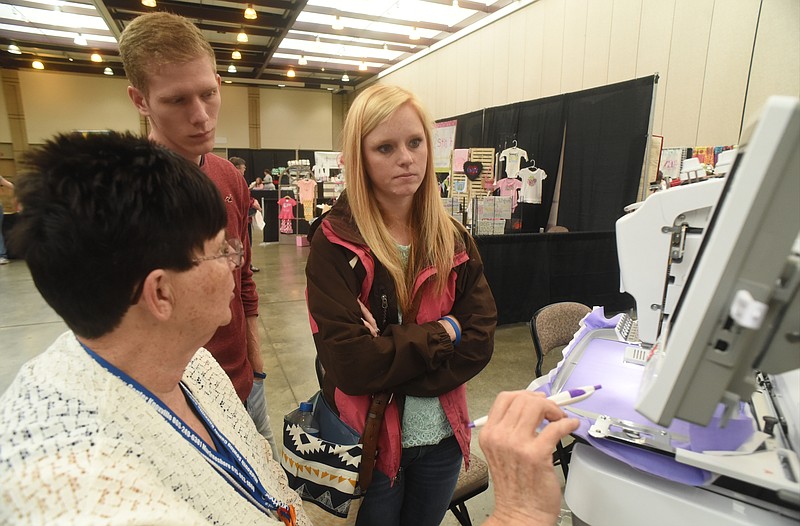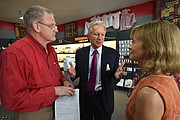At 69, Hanspeter Ueltschi is four years younger than Mick Jagger and has the same wiry frame, elegant style and a full head of silver hair. Last week, women were lining up for him to autograph their sewing machines and owner's manuals not their T-shirts because Ueltschi is known as the "rock star of sewing."
His fans know him as the fourth-generation owner and CEO of sewing-machine maker Bernina International and each year he chooses a few American cities to visit. Chattanooga and Atlanta were his 2016 choices.
"Each year, I visit stores in America that have done unusually well," Ueltschi said.
He traveled all the way from the Switzerland headquarters of Bernina for a meet-and-greet in Bernina Sew N Quilt Studio, a small store tucked into a strip mall on Shallowford Road near a shooting range and a sandwich shop.
Sew N Quilt has been thriving so much, Ueltschi's first duty last week was to cut the ribbon officially opening its new addition. A crowd of about 150 women and a scattering of men swirled around the sewing demos on the Bernina machines. The attendees reflected the turnout at a recent embroidery conference in Chattanooga - mostly women, some in their 20s but the majority middle-aged or older.
However, Ueltschi said it's millennials who are helping the most to increase the amount of sewing business in Sew N Quilt and other sewing shops.
"The millennials are giving us a good increase in business; they grew up watching 'Project Runway,'" Ueltschi said, mentioning the reality TV show for aspiring fashion designers.
"Project Runway" fans know that gifted fashion artists often fail at contests because they can draw a beautiful design but model and host Heidi Klum and her panel of judges give scathing critiques of the sewing. Nina Garcia, the fashion editor for Elle and Marie Claire magazines and one of the judges on "Project Runway," repeatedly warned on the show that fashion lovers need to understand how to sew so they can learn how seams make a garment properly fit and enhance a human's body.
"The year we fell off the worldwide economic cliff, that was 2007," Ueltschi said. "My store owners told me that we needed to get a younger generation of customers if we wanted to continue to prosper. The recession inspired a do-it-yourself attitude among young people. They wanted to learn to sew so they could dress well on a budget. We created a lower priced sewing machine model for them."
Keep in mind that lower-priced model starts at $700, a bit high for an aspiring fashion designer still working as a barista in a coffeehouse. But Ueltschi touts it as worth the money, saying it enhances the creative process because it is so quiet - no clattering like Grandma's sewing machine - and is an easy blend of software tech and artistry.
Steve Coakley of Ready Set Sew on Ringgold Road in East Ridge said he plans to expand his store because business has been so good.
"We get a lot of people in the door through our classes," Coakley said.
The store has classes for beginners, he said, "and yes, men do come to those lessons. They seem to find it relaxing."
Forget images of Jane Austen dreaming of novels while she tediously stitches a pattern in her embroidery hoop. These days, much of home hobbyist sewing is computer-controlled. Users can program the colors of thread and types of stitches, even the pattern, and the machine will follow the lines of the design, switching threads, stitches and colors when needed.
Ueltschi maintains that what is created on those machines can still reflect an individual's vision as much as any hand-sewnpiece. In 1893, Ueltschi's ancestor Karl Friedrich Gegauf invented the hemstitch machine that could sew 100 stitches per minute, so Ueltschi has always viewed technology and sewing have been mingled for more than a century.
At an embroidery conference in the Chattanooga Convention Center two weeks ago, one machine was topped with 10 types of thread - plum, marigold, silver, sky blue, lavender, jade, glittery gold and other hues - and, in about 30 minutes, used them to embroider nightingales and peacocks flitting through a garden of cherry blossoms, roses and orchids. The Arabian Nights fantasy could easily have taken months to stitch by hand.
At the convention, North Carolina sewing artist and entrepreneur Anna Miller, 26, watched one machine guide a needle effortlessly over the outline of a rose that soon bloomed with pink and orange thread.
"I run a business where I embroider and appliqué everything from T-shirts to purses," Miller said, "and I sell a lot of items that I make on Etsy.
"To me, sewing on a machine like this," she said, nodding toward the computer screen attached to the sewing machine, "is still an art because I can design the pattern, pick the colors of thread - just like a painter would pick pigments and pick how short or long the brushstokes will be - by choosing the type of stitch."
Some men attended embroidery seminars at the convention, but the crowd was mostly women. How to get more guys in the doors of sewing stores is often debated by those in the business. Offering free beer with lessons in how to sew a Super Bowl-themed might be a draw but also could result in mangled fingers and broken needles.
Lauren Byrne is starting a murder-mystery quiltmaking class in June that she hopes guys might like. Different blocks of the quilt contain clues, so the quilters can debate the evidence as they sew. The identity of the killer is revealed in the last block, she says.
But admittedly, sewing's main draw will probably be the creative impulse that prompted retired art teacher Kay Donges to sew a beautiful quilt portrait of one of her male high school students from long ago. The portrait is now on display in the Bernina Sew N Quilt Studio.
Donges took photos of each of her students so they could use the picture to do a self-portrait; she kept the male student's photo because his eyes were so kind and perceptive, she said.
"He was living in a bad neighborhood in a bad family situation, but he was always so sweet and positive - and then he dropped out and I couldn't find out what happened to him," Donges said.
In the passing years she forgot his name yet found his old photo "so I felt driven to do a portrait of him," she said. "I've asked all the Facebook friends I have who were pupils or teachers at that school, but no one can remember his name."
She would like to show him the quilt, but no one even knows if he is alive or where he might be living.
"I still see that glow in his eyes, so here's what I named it, " she said, flipping the corner of the quilt up to reveal the word:
"Hope."
Contact Lynda Edwards at 423-757-6391 or ledwards@timesfreepress.com.

